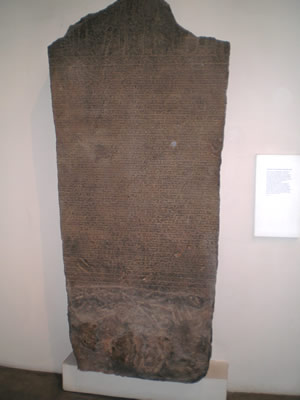Amanirenas facts for kids
Quick facts for kids Queen Amanirenas |
|||||
|---|---|---|---|---|---|
| Queen of Kush | |||||

Meroitic Stela found at Hamadab
|
|||||
| Reign | c. 40–10 BC | ||||
| Predecessor | Teriteqas | ||||
| Successor | Amanishakheto | ||||
| Born | 60s–50s BC | ||||
| Died | c. 10 BC | ||||
| Burial | Jebel Barkal (Bar. 4?) | ||||
| Issue | Akinidad | ||||
|
|||||
| Dynasty | Meroitic period | ||||
Amanirenas (also called Amanirena) was a powerful queen of the Kingdom of Kush. She ruled from about 40 BC to 10 BC. Her full title showed she was a strong leader. She was known as a qore (ruling king) and a kandake (ruling queen or queen mother).
Amanirenas is one of the most famous kandakes in history. She led the Kushite armies against the mighty Romans. This war lasted for five years, from 27 BC to 22 BC. The Kushites won an early victory by attacking Roman Egypt. But later, the Romans, led by Gaius Petronius, pushed them out. The Romans then set up a new border at a place called Maharraqa. Amanirenas was known for being very brave. She was also blind in one eye.
Ancient writings from Kush show Amanirenas had both the titles of qore and kandake. This means she was a queen who truly ruled. Many historians believe she is the "Candace" mentioned by the Roman writer Strabo. He wrote about the war between Kush and the Roman Empire. Her name is linked to Teriteqas and Akinidad. However, their exact family connection is not fully clear.
Queen Amanirenas and Rome
First Fights with Rome
In 24 BC, the Roman governor of Egypt, Aelius Gallus, was away. He was on a military trip in Arabia. This was a chance for the Kushites to attack. Queen Amanirenas and Akinidad led their forces. They defeated Roman soldiers at Syene and Philae.
The historian Neil MacGregor talks about Strabo's writings. Strabo described a "fierce one-eyed queen Candace." She captured several Roman forts in southern Egypt in 25 BC. Her army brought back a special prize. It was a bronze head of the Roman emperor Augustus. This head was taken from a statue of the emperor. The head was found in Meroë in 1912. Today, you can see it at the British Museum.
Petronius's Campaign
Later that same year, the Kushites were forced out of Syene. This was done by Gaius Petronius, the new Roman governor in Egypt. Strabo wrote a detailed report about what happened. Roman troops went deep into Kush. They even reached the city of Napata. The Romans eventually pulled back to the north. But they left soldiers at Qasr Ibrim (Primis). This place became the new border of the Roman Empire.
The Kushites tried again to take Primis. But Petronius stopped their attempt. After this, talks began between Kush and Rome. The Meroites (Kushites) sent people to meet Emperor Augustus. He was in Samos at the time. In 21 or 20 BC, a peace treaty was signed. This treaty was very good for the Meroites. The Romans left the southern part of a disputed area. This included Primis. Also, the Meroites did not have to pay taxes to the Roman Emperor.
However, the Romans kept control of a military border zone. This area was called the "Twelve-Mile Lands." So, the border was now near Maharraqa. This agreement lasted for a long time, until the late 200s AD. During this period, relations between Kush and Roman Egypt were mostly peaceful. However, the Kingdom of Kush started to lose its power around the first or second century AD.
See also
 In Spanish: Amanirena para niños
In Spanish: Amanirena para niños

